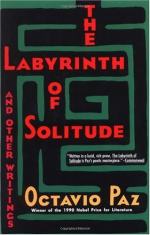
|
| Name: _________________________ | Period: ___________________ |
This test consists of 15 multiple choice questions and 5 short answer questions.
Multiple Choice Questions
1. What metaphor does Paz use to describe Mexico taking control from Spain?
(a) A phoenix rising from the ashes.
(b) A corpse dismembered and a nation born.
(c) A lion cub overtaking its elderly parent.
(d) A young man finally realizing his strength.
2. How did Paz see the 20th Century?
(a) A time when the common man asserted himself.
(b) A time when all historical eras mingled and merged.
(c) A time when feudalism was finally thrown off.
(d) A time when dictators took more power than ever before.
3. Where have the great revolutions of the 20th Century occurred?
(a) In backward countries.
(b) In large, wealthy countries.
(c) Among indigenous tribes.
(d) In places with little modern culture.
4. How did liberalism and democracy function in South American countries?
(a) As the breath of fresh air, politically speaking.
(b) As the new structure of governments around the continent.
(c) As a veneer for the workings of colonialism.
(d) As an impetus to move the countries into modernity.
5. What did Moctezuma think as the Spaniards approached?
(a) That was the time to prove his manliness.
(b) The gods had abandoned him.
(c) He would finally become Divine.
(d) That was the moment of his deliverance.
6. Why have Mexican culture and politics vacillated from one extreme to another? (Chapter Seven, page 157).
(a) Because there has never been a strong Mexican leader.
(b) Because Mexicans cannot invent their history from the beginning.
(c) Because Mexicans deny their Spanish and Indian heritage.
(d) Because Mexicans have difficulty synthesizing experiences.
7. Why did the Mexican Revolution have to begin before the beginning?
(a) The cities were not large enough to house the farmers-turned-workers.
(b) The people still held a feudalistic mindset.
(c) Mexico did not have the basic electricity and resources needed to transform her cities.
(d) In the early 20th Century, Mexico was far behind the advanced world.
8. When did the Plan of Ayala go into effect?
(a) January, 1909.
(b) July, 1937.
(c) March, 1951.
(d) November, 1911.
9. In Asia and Africa, what two seemingly-contradictory ideologies are being used?
(a) Revolutionary aspiration and nationalism.
(b) World power and individualism.
(c) Colonial past and nationalism.
(d) Future dreams and individualism.
10. According to Paz, what philosophical fact defines much of Mexico's history?
(a) They overturned several of Spain's philosophical treatises.
(b) The people adopted some ideas and invented others.
(c) They had only two great thinkers.
(d) The people adopted ideas, but did not invent their own.
11. What important circumstance did early revolutionary governments not take into account?
(a) Expansion of cities.
(b) Population growth.
(c) Desertion of rural areas.
(d) Natural resources.
12. Mexico lacks basic industries except for one - what is it?
(a) Fishing.
(b) Forestry.
(c) Steel.
(d) Wool.
13. Whom did Paz call the "guardian of freedom and traitor to his country"? (Chapter Six, page 125).
(a) Benito Juarez.
(b) Santa-Ana.
(c) Valentin Gomez Farias.
(d) Jose Maria Mora.
14. In Paz's argument, how have tradition and religion always been presented to the Mexicans?
(a) As things leading to their spiritual salvation.
(b) As things to be held lightly or discarded.
(c) As things that will solidify their national identity.
(d) As things that stifle their individuality.
15. What economic goal did the Revolution have?
(a) To free Mexico from dependence on Spain.
(b) To establish commerce and industry.
(c) To improve the commerce that had already been established.
(d) To pull the nation out of poverty.
Short Answer Questions
1. What did positivism do with the ideals of the Reformation?
2. What was the motto of positivism?
3. According to the tribe of the Chamulas, what is a chulel?
4. In Jose Gaos' thought, what unique opportunity do young people have through their education?
5. What did the Spaniards find when they arrived in South America?
|
This section contains 668 words (approx. 3 pages at 300 words per page) |

|




